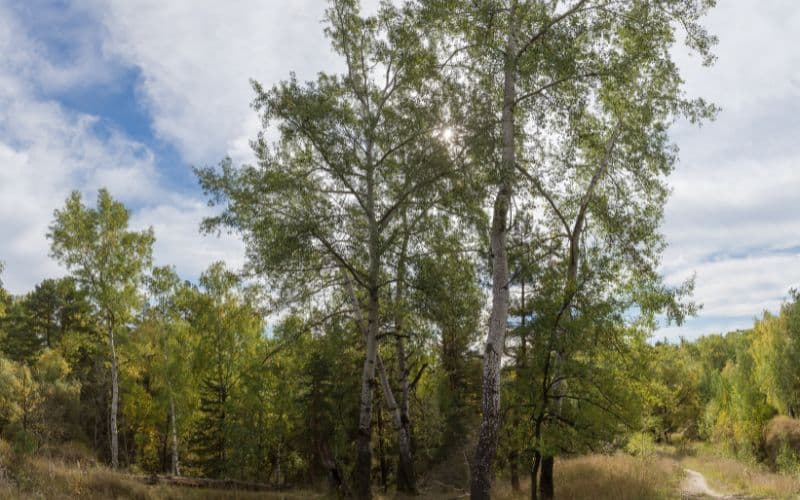
Tucked away in the heart of Ontario, trembling aspens present a spectacle that’s not just pleasing to the eyes but also a subject of great ecological interest. Their mesmerising golden-yellow hues in autumn create an unforgettable panorama, offering you an opportunity to connect with nature at its finest.
However, it isn’t all about aesthetics when it comes to these remarkable trees. Trembling aspens play a crucial role in maintaining biodiversity and providing habitat for numerous species. From their fluttering leaves that produce soothing sounds on breezy days, down to their complex root systems harbouring life underground – every aspect of these trees contributes significantly towards Ontario’s vibrant ecosystems.
Furthermore, trembling aspens have some fascinating characteristics up their sleeves that might surprise even those familiar with them! Their resilience is impressive – they’re among the first species capable of thriving after wildfires or heavy logging activities; they spread swiftly across landscapes by creating ‘clones’ through root sprouts; and they can live for hundreds if not thousands of years under favourable conditions!
With so much going on beneath (and above) ground level involving trembling aspens in Ontario, wouldn’t you want to know more? This article aims precisely at that – unfolding various aspects related this amazing tree species native your region while ensuring we don’t lose sight from appreciating its sheer beauty along the way!
Understanding Trembling Aspens: An Overview
Step into any Ontario forest and you’re likely to come across the trembling aspen, a tree known for its distinctive quaking leaves. This species, also known as Populus tremuloides, gets its name from the way its leaves flutter in even the slightest breeze.
To start with, it’s important to understand that these trees are an integral part of Ontario’s ecosystem. They act like a pioneer species by quickly colonising areas disturbed by fire or logging. This ability is due to their unique reproductive system – they propagate through suckering, creating clones of themselves which can spread rapidly over large areas.
But what makes these trees truly stand out? Well, it’s all down to their captivating leaf movement. The petioles (leaf stalks) are flattened sideways causing them to tremble in wind providing quite a spectacle for nature lovers! Here’s another fascinating fact – this trembling effect isn’t just visually appealing; it aids photosynthesis by ensuring all parts of the leaf receive sunlight throughout different times of day.
The humble trembling aspen doesn’t stop there though; It has other tricks up its sleeve too! These trees offer great benefits such as improving air quality and providing habitat for various wildlife species including birds and insects:
- Air Quality: Aspens absorb pollutants like carbon dioxide from our atmosphere while releasing oxygen.
- Wildlife Habitat: With thickets providing cover and their bark serving up winter food source for deer and moose among others!
From every angle then – whether ecological or aesthetic – Ontario’s trembling aspens certainly hold significant value within our environment!

The Unique Characteristics of Trembling Aspens
You’ll be intrigued to know that the trembling aspen, known scientifically as Populus tremuloides, boasts a plethora of unique features. It’s not just another tree in Ontario’s diverse woodland; it truly stands out.
Firstly, let’s consider its mesmerising appearance. With bark that shines white to greenish-white and leaves that flutter at the slightest breeze (hence ‘trembling’), it’s no surprise these trees catch your eye. And when autumn arrives? You’re treated to a brilliant display of golden-yellow foliage.
- Colour: White/Greenish-white
- Autumn Foliage: Golden-yellow
What sets trembling aspens apart from their arboreal counterparts is their fascinating biological quirks. Believe it or not, they possess an extraordinary ability for clonal reproduction! This means one parent tree can produce multiple offspring through root suckers – shoots sprouting directly from its root system.
Now you might think this makes for rather uniform forests but here’s where things get interesting: each clone varies slightly in characteristics like leaf shape and disease resistance due to natural mutations over time!
Another compelling feature lies beneath the surface – literally! Trembling aspens have one of the most extensive root systems among all trees which allows them access resources even under harsh conditions and compete effectively with other plants for survival.
In terms of lifespan too, these beauties are quite remarkable. While individual stems usually survive around 150 years (which is impressive enough), underground parts can live thousands more – making them some oldest living organisms on Earth!
Don’t forget about their role in supporting biodiversity either; trembling aspen ecosystems harbour numerous plant species and provide food & shelter to a range of wildlife including insects, birds & mammals such elk or bear which feast on young shoots & leaves during springtime.
Trembling Aspens in Ontario’s Diverse Ecosystems
Ontario, with its sprawling landscapes and diverse ecosystems, is home to a unique tree species known as the trembling aspen. You’ve likely seen these trees before – their distinctive white bark and fluttering leaves are hard to miss.
Amongst Ontario’s myriad flora, trembling aspens stand out for their adaptability. They’re found everywhere from dry uplands to river banks. Thriving in various soil types ranging from sandy loam to clayey silt, it’s no surprise that they’ve earned the title of ‘generalist’ among tree species.
Here are some quick stats about these fascinating trees:
| Average Height | Lifespan | Preferred Soil Type |
|---|---|---|
| 15-25m | 50-100 years | Sandy Loam |
The trembling aspen isn’t just a survivor; it’s also an ecological powerhouse. In springtime, you’ll see them teeming with life – birds nesting amongst branches and insects feasting on fresh buds. This robust activity doesn’t end at fauna; they play a significant role within the plant community too!
- Their rapid growth post-fire helps re-establish vegetation cover.
- By dominating early-succession environments after disturbances like logging or windstorms
- Their extensive root systems prevent soil erosion
Their benefits extend beyond environmental contributions – humans have been utilising this resourceful tree for centuries! Here’s how:
- Indigenous communities used its lightweight wood for making tools
- Its inner bark was consumed during food shortages
- Therapeutic properties of its bark were harnessed in traditional medicine
Trembling aspens truly encapsulate resilience amidst diversity – whether adapting to varied environments or providing resources across seasons! Despite challenges such as climate change and pests like forest tent caterpillars which occasionally cause defoliation , these trees stand tall, a testament to their adaptability and importance within Ontario’s diverse ecosystems.
Threats and Conservation Efforts for Ontario’s Aspens
Ontario’s trembling aspens face a myriad of threats that are putting their survival at risk. Pests, particularly insects like the forest tent caterpillar, have become a major concern. These leaf-eating bugs can cause extensive defoliation which weakens the trees and leaves them susceptible to disease and other pests.
Another considerable threat comes from climate change. The increasing temperatures may lead to drought conditions that these trees aren’t adapted to survive in. Moreover, the rapid shifts in weather patterns can also contribute to increased susceptibility towards diseases.
| Threat | Effect |
|---|---|
| Pests | Extensive defoliation leading to weakened health |
| Climate Change | Increased vulnerability towards diseases due to stress |
When it comes down to conservation efforts for these beautiful trees, numerous strategies have been put into place by various environmental organisations across Ontario. One such strategy involves promoting biodiversity within forests which helps create a more resilient ecosystem less prone to pest infestations or disease outbreaks.
Here are some of the key conservation measures being implemented:
- Encouraging natural regeneration of aspen stands
- Planting native tree species alongside aspens
- Monitoring forest health regularly
The future may seem uncertain but with consistent efforts dedicated towards their protection, there’s hope yet for Ontario’s trembling aspens.

Conclusion: The Importance of Preserving the Trembling Aspen
It’s time to grasp the real importance of preserving Ontario’s trembling aspens. These trees aren’t just an integral part of our landscape; they’re a critical component in maintaining ecological balance.
Preserving these trees isn’t simply about keeping our forests looking lush and beautiful. It goes much deeper than that. When you protect the trembling aspen, you’re also safeguarding habitats for various species, contributing to carbon sequestration, and helping maintain soil health.
Here are some vital reasons why we need to conserve these stunning trees:
- Habitat Provision: Aspens provide shelter and food for countless wildlife species like birds, insects, mammals.
- Carbon Sequestration: They play a significant role in combating climate change by absorbing CO2 from the atmosphere.
- Soil Health Maintenance: Their extensive root systems prevent soil erosion while promoting nutrient cycling.
Let’s take a look at some numbers underscoring their value:
| Value | |
|---|---|
| Carbon absorbed annually per acre (kg) | 2000 |
| Wildlife Species Supported | Over 80 |
Now it’s your turn to act! By doing your bit – whether it’s supporting local conservation efforts or educating others about their significance – you can help preserve these magnificent giants for future generations.
Remember – every effort counts when it comes to protecting our natural heritage! So let’s roll up those sleeves and do what we can today because tomorrow might be too late. Let us ensure that Ontario’s trembling aspens continue adding charm to our landscapes while playing their pivotal environmental roles.








